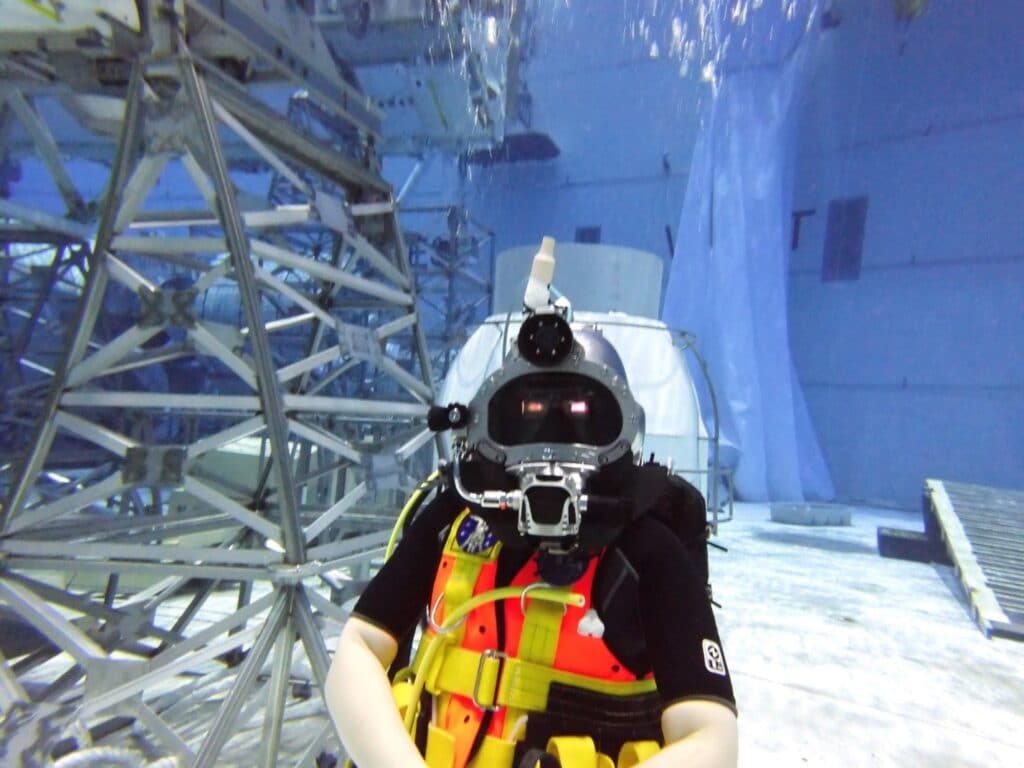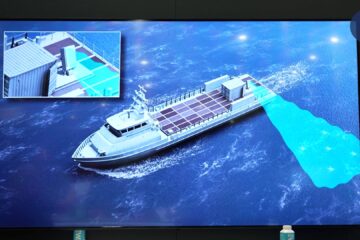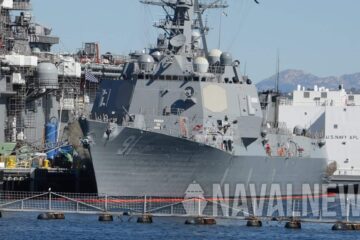This helmet’s HUD can aid divers in “seeing” in the dark
ONR provided $1 million in FY2020 for the DAVD Generation 2 development and is pressing forward with the DAVD Generation 3 development for FY2021. DAVD is an “eyeglasses-designed high-resolution heads-up display monitor” over each eye (similar to Virtual Reality glasses) and is separate from the dive helmet.
According to the NAVSEA press release:
The first-generation DAVD system delivered by the SUPSALV [Supervisor of Salvage and Diving] office in collaboration with Naval Surface Warfare Center Panama City Division, Office of Naval Research, and Coda Octopus® Group, Inc. in 2020, enabled divers to receive step-by-step instructions via its high-resolution heads-up display (HUD) when completing complicated tasks. Additionally, the DAVD used active sonar to provide divers with basic navigation data when operating in low visibility environments. This next-generation DAVD brings in enhanced heading accuracy, the ability to receive sonar input from other sources outside of the helmet, and improvements to the navigation system that includes the ability to set way points and share bearing, range, and enhanced camera imagery directly with the HUD.
“`DAVD has been a game-changer for Navy Divers,’” said SUPSALV’s Commander, Capt. Jay Young. “`With the high-rez sonar display, our divers can navigate around obstacles in low and no visibility conditions which means they can safely execute their mission and maximize productivity when we’re on the bottom.’”
“`This was our last check before we introduce the Generation 2 DAVD system to the Fleet,’” said Paul McMurtrie, SUPSALV’s Diving Systems Program Manager who oversees the DAVD program. “`It provides nearly limitless capabilities that can transcend diving. The inherent adaptably is what may take this technology from the ocean floor to, potentially, the dark side of the moon,’” he said.
“`Our divers came to us with their issue – specifically that they usually work in murky water and rely on their sense of touch to navigate around the bottom of the water column which is neither safe nor efficient,’” said ONR’s program lead Sandra Chapman. “`With an investment of about $1.2 million over five years, we started developing a system that can fit inside the diver’s existing helmet. It’s amazingly rewarding to know that DAVD is helping to keep our divers safe and to think that it could end up in space is amazing.’”
Naval News Comments

For purely speculative military naval analysis discussion for this article, the Generation 2 DAVD system can provide deep sea naval divers, salvage specialists, underwater investigators and inspectors, special operations operators, and Explosive Ordnance (Mine) Disposal personnel critical informative navigation, symbology, positioning, sonar data, identification, targeting, audio, and imagery onto the heads-up display for much better and improved efficiency and mission time-to-task performance. Before, many naval divers who operated clandestinely had to walk on the bottom of the ocean floor, practically unable to see far, and use their sense of touch with arms outstretched in the deep, dark, frigid waters to remember underwater debris (landmarks), pier pilings, rocks, seaweed, wrecks, and terrain, as described in the book No Hero written by former Navy SEAL alias “Mark Owen.”
In the future, DAVD could also help NASA’s astronauts navigate the dark side of the Moon and conduct crater and interior tunnel Moon inspections, mineral mining, and construction operations in total darkness using the HUD to feed instructions, imagery, technical manuals, video, communications, safety protocols, and navigation data, respectively. DAVD truly is a game changer for operating in vast barren featureless environments in total darkness.
According to the Coda Octopus Group, Inc.’s website, The Diver Augmented Vision Display (DAVD) GEN 2’s helmet has a transparent HUD offering full real-time Mixed-Reality 3D software for images, ranges and directions to waypoints and hazards, technical manuals, dive timer, instructions, text, video, images, and sonar data.
The Kirby Morgan helmet with DAVD can have a digital low-light television camera, an oxygen regulation system, a sonar system, a head motion tracker, and digital audio. The Coda Octopus® Group Inc.’s DAVD helmet can support Coda’s 4G communications, and data exchange software, in addition to 3D area scan and a dive simulator software that uses 3D image models from a Media Library to augment training, and can mix with LIVE images.
According to the Coda Octopus Group’s website, The U.S. Navy can benefit from using DAVD in the following areas:
- Swimmer Delivery Vehicles
- Mine Countermeasures
- Ship Hull Inspection
- Salvage and Diver Support
- Critical Asset Inspection
- Real-Time Threat Detection





All above images: Coda Octopus Group, Inc.






